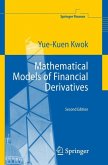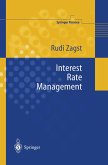In the 2nd edition some sections of Part I are omitted for better readability, and a brand new chapter is devoted to volatility risk. As a consequence, hedging of plain-vanilla options and valuation of exotic options are no longer limited to the Black-Scholes framework with constant volatility.
In the 3rd printing of the 2nd edition, the second Chapter on discrete-time markets has been extensively revised. Proofs of several results are simplified and completely new sections on optimal stopping problems and Dynkin games are added. Applications to the valuation and hedging of American-style and game options are presented in some detail.
The theme of stochastic volatility also reappears systematically in the second part of the book, which has been revised fundamentally, presenting much more detailed analyses of the various interest-rate models available: the authors' perspective throughout is that the choice of a model should be basedon the reality of how a particular sector of the financial market functions, never neglecting to examine liquid primary and derivative assets and identifying the sources of trading risk associated. This long-awaited new edition of an outstandingly successful, well-established book, concentrating on the most pertinent and widely accepted modelling approaches, provides the reader with a text focused on practical rather than theoretical aspects of financial modelling.
In the 3rd printing of the 2nd edition, the second Chapter on discrete-time markets has been extensively revised. Proofs of several results are simplified and completely new sections on optimal stopping problems and Dynkin games are added. Applications to the valuation and hedging of American-style and game options are presented in some detail.
The theme of stochastic volatility also reappears systematically in the second part of the book, which has been revised fundamentally, presenting much more detailed analyses of the various interest-rate models available: the authors' perspective throughout is that the choice of a model should be basedon the reality of how a particular sector of the financial market functions, never neglecting to examine liquid primary and derivative assets and identifying the sources of trading risk associated. This long-awaited new edition of an outstandingly successful, well-established book, concentrating on the most pertinent and widely accepted modelling approaches, provides the reader with a text focused on practical rather than theoretical aspects of financial modelling.
From the reviews: " ...This book is an impressive work of scholarship in mathematical finance in the area of option pricing. ...contains the latest results and references. ...The presence of many explicit formulae, for various types of derivatives, will make this book attractive to practitioners; and its breadth of content will make it useful for anyone who considers research in mathematical finance." (The Australian and New Zealand Journal of Statistics) " ...On the whole, this book presents a very wide range of topics and will appeal to both practitioners and mathematicians. ...the second part gives an excellent overview of the state of the art in term structure research and will set a clear standard for some time to come." (MathSciNet) " ...The book contains a wealth of material expressed in a clear mathematical way. A definite bonus is the very extensive list of references which gives the reader a most welcome basis from which to explore further the realm of mathematical finance. ...The book can be used ideally both as an introductory and as an advanced text on mathematical finance." (Short Book Reviews) " ...This book is a comprehensive and up-to-date presentation of the martingale approach for pricing and hedging derivative securities. ...provides a wide range of topics and will appeal to both practitioners and mathematicians. When only special cases or models are provided, the authors give useful references that will help researchers to obtain even more insight in the topics." (ZentralblattMATH) From the reviews of the second edition: "The book starts at an elementary level of mathematics as well as of market and product knowledge. ... In summary, the book gives a very broad insight into advanced modern financial mathematics, in particular fixed income models. ... It will serve as a basic source of knowledge of the described topics in financial mathematics." (Ludger Overbeck, Mathematical Reviews, Issue 2005 m)









